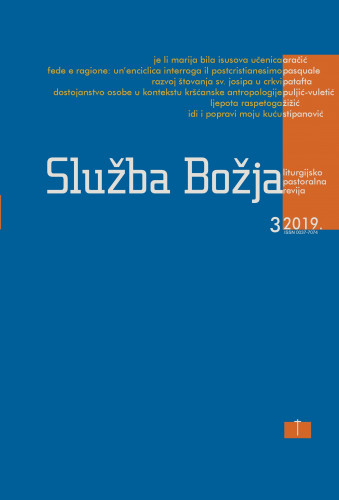Među tradicionalnim katoličkim pobožnostima važno mjesto zauzima štovanje sv. Josipa. Ovo štovanje počelo je zamirati nakon Drugoga vatikanskog sabor zbog krize teologije i pučke pobožnosti, da bi u novije vrijeme počelo doživljavati svoju polaganu obnovu. U ovom radu nastoji se dati kroz izabrane tekstove iz otačkog razdoblja, kojih je vrlo malo, preko skolastičke teološke refleksije do papinskih dokumenata razvoj teološkog promišljanja i štovanja sv. Josipa od razdoblja ranog kršćanstva, odnosno otačkog razdoblja do Drugoga vatikanskog sabora. Rad prati ovaj razvoj kroz dva velika razdoblja, to je prvo razdoblje teoloških refleksija kod crkvenih otaca, napose sv. Augustina i vremena srednjeg vijeka, kad u visokoj skolastici započinje sustavno teološko promišljanje o sv. Josipu, gdje je temelje postavio sv. Toma Akvinski, a širenju pobožnosti pridonio sv. Bernardin Sijenski. Drugo je razdoblje vrijeme od početka katoličke obnove do Drugoga vatikanskog sabora, kada teološka misao pada u drugi plan, a u središte dolazi pobožnost i ističe se uloga sv. Josipa kao zaštitnika Crkve pred snažnim promjenama s kojima se Crkva suočavala u 19. i početkom 20. stoljeća. Teološka misao ovoga razdoblja temelji se na razvijanju skolastičkih zasada, često bez kritičkog pristupa i pod snažnim utjecajem pučke pobožnosti. Dominantnu ulogu u promicanju štovanja sv. Josipa u 19. i početkom 20. stoljeća preuzimaju pape koji u širenju štovanja sv. Josipa vide važnu duhovnu i pobožnu praksu kojom se vjernici potiču da se utječu sv. Josipu svojim molitvama kako bi zaštitio Crkvu. Umjesto zaključka doneseno je jedno promišljanje koje može biti poticaj za novu obnovu štovanja sv. Josipa u novim okolnostima u odnosu prema potrebama suvremenog društva i Crkve, a da se ne izgubi zdravi duh i velika vrijednost svetačkog lika sv. Josipa koja je stoljećima nadahnjivala katoličku duhovnost i pobožnost.; Among traditional Catholic devotions, the worship of St. Joseph occupies an important place. This worship began to fade away after the Second Vatican Council due to the crisis of theology and folly of devotion; recently it has experienced its slow renewal. In this paper, presenting the selected texts from the period of Church Fathers, through the scholastic theological reflection, to papal documents, we are trying to show the development of theological reflection and worship of St. Joseph from the period of early Christianity, to the period of Church Fathers and to the Second Vatican Council. The work itself follows this development through two great periods. The first period of theological reflection is the time of Church Fathers, especially Augustine, and the Middle Ages, the time when high scholasticism began with a systematic theological reflection on St. Joseph, when St. Thomas Aquinas laid foundations and St. Bernardino from Sienna contributed to the spread of devotion. The second period is the period from the beginning of the Catholic renewal to the Second Vatican Council, when theological thought ends up in the background and the center is devoted to the role of St. Joseph as the patron of the Church before the drastic changes that the Church faces in the 19th and early 20th centuries. The theological idea of this period is based on the development of scholastic principles, often without a critical approach and under the strong influence of popular devotions. The dominant role in promoting the worship of St. Joseph in the 19th and early 20th centuries was taken over by the Popes, who recognized an important and pious practice in spreading the worship of St. Joseph, the practice that encourages believers to recourse to St. Joseph with their prayers to protect the Church.
Sažetak

 Služba Božja : liturgijsko-pastoralna revija : 59,3(2019) / glavni i odgovorni urednik Ivan Macut.
Služba Božja : liturgijsko-pastoralna revija : 59,3(2019) / glavni i odgovorni urednik Ivan Macut.